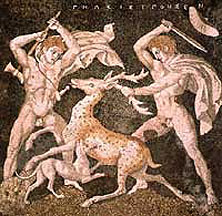.
Early Mosaics
The word "mosaic" derives from the Greek: "patient work, worthy
of the Muses".
 Bellerophon, riding Pegasus, slays the Chimaira,
Bellerophon, riding Pegasus, slays the Chimaira,
mosaic floor of a house, 432-348 BC, Olynthos |
 A deer hunt, detail from the mosaic floor signed Gnosis
in the
A deer hunt, detail from the mosaic floor signed Gnosis
in the
'House of the Abduction of Helen' at Pella, late 4th century BC, |
During the 4th millennium B.C. at South Mesopotamia (Sumerian), we find
the first kind of mosaic decoration with pieces of cockleshells, onyx
and clay in a temple at the ancient city of Ouruk. In West Asia Minor
(Greek Area), we find the most ancient samples of floors made of pieces
of rubble. Later on, during the first centuries A.C. we find floors with
complex drawings made with white or black natural pebbles in Olinthos
(Kassandra area in Greece) inspired mainly by ancient myths. In Pella
(Macedonia - Greece) during the 4th century B.C. we find floors made with
pieces of glass.
|

Herakleitos, The Unswept Floor, 2nd century CE
| The mosaic technique spread from Greek Asia Minor to Italy. It was developed
further there, especially in Pompeii and Rome. Romans decorated floors and
walls of houses, temples and baths, following a simple and 'monochrome'
technique. |

Roman mosaic of marine life |

Segment of Dionysian mosaic |
Common scenes among Roman mosaics were mythological lore of gods and demi-gods,
banquet scenes, still-lifes, hunting scenes, and underwater creatures. One
common theme in the mythological vein is that of various scenes from the life
of Dionysos (the god of wine, also known by the Romans as Bachus).
During the Byzantine Era, the art of mosaics reaches its highest level of
quality. Except floors and walls, artists decorate vaults and facades of temples
and palaces. They use pieces of marble, natural stones, colored glass, even
gold and silver. Themes in this era are various, but most were inspired by
the Christian religion that was dominant during this period.
|